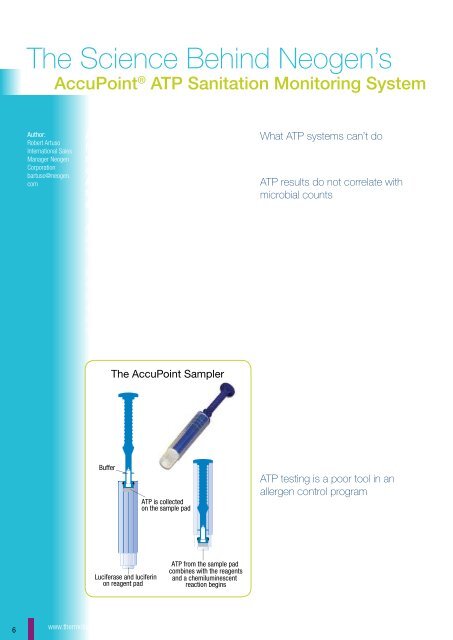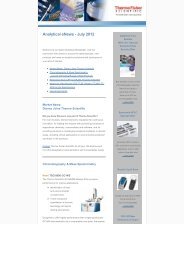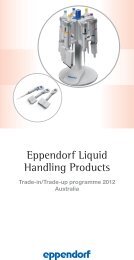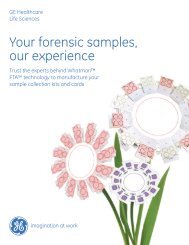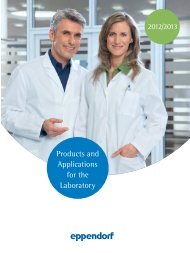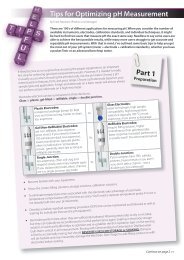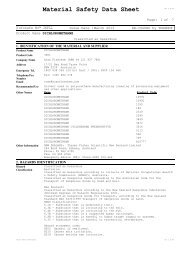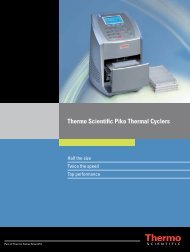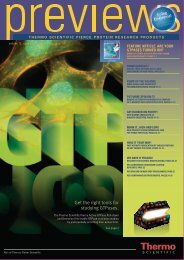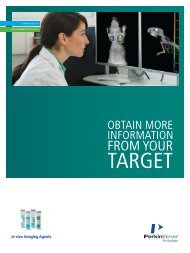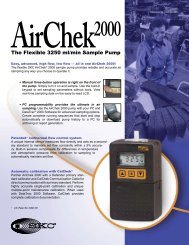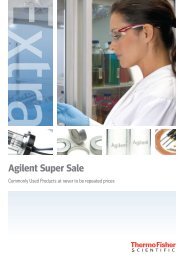Dairy Insider - Thermo Fisher
Dairy Insider - Thermo Fisher
Dairy Insider - Thermo Fisher
Create successful ePaper yourself
Turn your PDF publications into a flip-book with our unique Google optimized e-Paper software.
The Science Behind Neogen’s<br />
AccuPoint ® ATP Sanitation Monitoring System<br />
Author:<br />
Robert Artuso<br />
International Sales<br />
Manager Neogen<br />
Corporation<br />
bartuso@neogen.<br />
com<br />
Adenosine triphosphate (ATP) is<br />
found in every living cell. Since<br />
most of the food and drink we<br />
consume was at some point living,<br />
ATP is present in most residue<br />
that remains after a food contact<br />
surface is cleaned.<br />
ATP is also present in bacteria as well<br />
as yeast and mold or other spoilage<br />
organisms.<br />
For this reason, the measurement of ATP<br />
levels on a food contact surface or within<br />
a water sample has become the de-facto<br />
standard food and beverage producers<br />
utilise to determine the cleanliness levels<br />
of their operations.<br />
Buffer<br />
The AccuPoint Sampler<br />
Luciferase and luciferin<br />
on reagent pad<br />
ATP is collected<br />
on the sample pad<br />
ATP from the sample pad<br />
combines with the reagents<br />
and a chemiluminescent<br />
reaction begins<br />
What ATP systems can’t do<br />
ATP systems are not designed for total plate counts, or<br />
detecting food allergens.<br />
ATP results do not correlate with<br />
microbial counts<br />
A common misconception is that the results received from<br />
ATP testing systems in relative light units (RLUs) for surface<br />
samples, for example, should in some way correlate with a<br />
microbial total plate count result for the same samples.<br />
The amount of ATP in microbial cells can vary dramatically<br />
and a single CFU can actually be comprised of one cell or<br />
many cells. Bacteria need food to grow, and therefore, there<br />
will never be an occasion where there is only microbial ATP<br />
on a surface.<br />
In theory there is a correlation between CFU levels and RLU<br />
units; however, it is impossible to determine whether the<br />
RLU results are due to the presence of bacteria, yeast, mold<br />
or food residue. Most probably, it is a combination of these<br />
things.<br />
ATP systems are not direct indicators of bacterial presence;<br />
however, they are the fastest and most convenient method<br />
for determining the potential for these organisms to exist<br />
on your food contact surface - therefore an indication of<br />
how clean your surfaces are. There is simply no faster or<br />
easier way to know that you could have a problem or that<br />
certain areas in your facility require more vigorous cleaning.<br />
Therefore, the issue can be corrected before it becomes a<br />
serious problem.<br />
ATP testing is a poor tool in an<br />
allergen control program<br />
Another misconception is the use of ATP sanitation<br />
monitoring systems in a food allergen control program. The<br />
theory here is that if all or most of the ATP on a surface or<br />
in a clean-in-place (CIP) system has been eliminated, all<br />
of the possible allergenic protein has also been eliminated.<br />
This is not the case as 1) An allergenic protein can exist on<br />
a surface at up to 100 times the level of concern and still be<br />
below the detection level of any ATP system; and 2) You can’t<br />
know how much of an ATP result is from an allergenic protein<br />
and how much is from something else.<br />
So why use an<br />
ATP monitoring system?<br />
»<br />
»<br />
The purpose of ATP testing is to achieve and defensively<br />
document effective cleaning by following the principle<br />
that if biomass is not present on surfaces after cleaning<br />
there is not enough medium for microbial growth.<br />
Properly utilised, sanitation monitoring systems allow for<br />
the almost instantaneous detection and measurement<br />
of ATP on food contact surfaces, which provides an<br />
objective, actionable tool for the monitoring of a facility’s<br />
sanitation efforts.<br />
Exclusive <strong>Dairy</strong> <strong>Insider</strong> Special<br />
For a limited time only the AccuPoint 2<br />
ATP Sanitation Monitoring system is $3600<br />
saving you $500 on upfront investment.<br />
This package includes software, USB data<br />
cable, battery charger, mobile carry case<br />
and training DVD.<br />
*Hurry this offer ends 31st August 2013.<br />
Quote promo code NEO9602<br />
Call 1300 735 292 to place your order or go to<br />
www.thermofisher.com.au/godirect to order online.<br />
$3600 *<br />
NEO9602<br />
6<br />
www.thermofisher.com.au<br />
1300 735 292<br />
7


